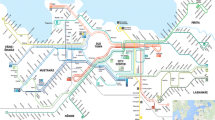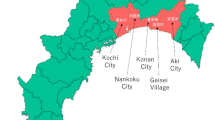Abstract
Fare change is an effective tool for public transit demand management. An automatic fare collection system not only allows the implementation of complex fare policies, but also provides abundant data for impact analysis of fare change. This study proposes an assessment approach for analyzing the influence when substituting a flat-fare policy with a distance-based fare policy, using smart card data. The method can be used to analyze the impact of fare change on demand, riding distances, as well as price elasticity of demand at different time and distance intervals. Taking the fare change of Beijing Metro implemented in 2014 as a case study, we analyze the change of network demand at various levels, riding distances, and demand elasticity of different distances on weekdays and weekends, using the method established and the smart card data a week before and after the fare change. The policy implication of the fare change was also addressed. The results suggest that the fare change had a significant impact on overall demand, but not so much on riding distances. The greatest sensitivity to fare change is shown by weekend passengers, followed by passengers in the evening weekday peak time, while the morning weekday peak time passengers show little sensitivity. A great variety of passengers’ responses to fare change exists at station level because stations serve different types of land usage or generate trips with distinct purposes at different times. Rising fares can greatly increase revenue, and can shift trips to cycling and walking to a certain extent, but not so much as to mitigate overcrowding at morning peak times. The results are compared with those of the ex ante evaluation that used a stated preference survey, and the comparison illustrates that the price elasticity of demand extracted from the stated preference survey significantly exaggerates passengers’ responses to fare increase.









Similar content being viewed by others
References
Abrate, G., Piacenza, M., Vannoni, D.: The impact of integrated tariff systems on public transport demand: evidence from Italy. Reg. Sci. Urban Econ. 39(2), 120–127 (2009)
Association of Train Operating Companies (ATOC): Passenger Demand Forecasting Handbook. Passenger Demand Forecasting Council, London (2002)
Barry, J., Newhouser, R., Rahbee, A., Sayeda, S.: Origin and destination estimation in New York City with automated fare system data. Transp. Res. Rec. 1817, 183–187 (2007)
Beijing Transportation Research Center: 2016 Beijing transport development annual report (2016) (in Chinese)
Bresson, G., Dargay, J., Madre, J., Pirotte, A.: The main determinants of the demand for public transport: a comparative analysis of England and France using shrinkage estimators. Transp. Res. Part A Policy Pract. 37(7), 605–627 (2003)
Chin, A., Lai, A., Chow, J.: Non-additive public transit fare pricing under congestion with policy lessons from toronto case study. In: Transportation Research Board 95th Annual Meeting (No. 16-1710) (2016)
Chen, F., Fang, J., Wu, Q.: Study of standing passenger density in subway cars based on passengers’ spatial comfort: case study of Beijing subway line 4. Transp. Res. Rec. J. Transp. Res. Board 2540, 84–91 (2016)
CityMetric: How much do Londoners spend on commuting. http://www.citymetric.com/transport/how-much-do-londoners-spend-commuting-1668 (2015). 19th Sep 2016
Dargay, J., Hanly, M.: The demand for local bus services in England. Transp. Econ. Policy 36, 73–91 (2002)
Devillaine, F., Munizaga, M., Trépanier, M.: Detection of activities of public transport users by analyzing smart card data. Transp. Res. Rec. 2276, 48–55 (2012)
Evans, J.E.I.V.: Transit pricing and fares: traveler response to transportation system changes. Transp. Res. Board 12, 1–59 (2004)
Farber, S., Bartholomew, K., Li, X., Páez, A., Habib, K.M.N.: Assessing social equity in distance based transit fares using a model of travel behavior. Transp. Res. Part A Policy Pract. 67, 291–303 (2014)
Finance Bureau of Beijing (FBB): Report on Budget Execution of 2013 and Budget Draft of 2014 of Beijing. http://www.mof.gov.cn/zhuantihuigu/2014yshb/201402/t20140219_1044590.html (2014). 19th Sep 2016
Gkritza, K., Karlaftis, M.G., Mannering, F.L.: Estimating multimodal transit ridership with a varying fare structure. Transp. Res. Part A Policy Pract. 45(2), 148–160 (2011)
Grange, L., González, F., Muñoz, J.C., Troncoso, R.: Aggregate estimation of the price elasticity of demand for public transport in integrated fare systems: the case of transantiago. Transp. Policy 29, 178–185 (2013)
Hensher, D.: Assessing systematic sources of variation in public transport elasticities: some comparative warnings. Transp. Res. Part A Policy Pract. 42(7), 1031–1042 (2008)
Hickey, R.: Impact of transit fare increase on ridership and revenue: metropolitan transportation authority, New York city. Transp. Res. Rec. J. Transp. Res. Board 1927, 239–248 (2005)
Holmgren, J.: Meta-analysis of public transport demand. Transp. Res. Part A Policy Pract. 41(10), 1021–1035 (2007)
Iseki H., Liu C., Knaap G.: Origin-Destination Land Use Ridership Model for Fare Policy Analysis for the Washington Metropolitan Area Transit Authority, National Center for Smart Growth Research and Education, University of Maryland, College Park. http://smartgrowth.umd.edu/assets/documents/announcements/landuseridershipmodel_finalreport.pdf (2015). 19th Sep 2016
Litman, T.: Transit price elasticities and cross-elasticities. J. Public Transp. 7(2), 37–58 (2004)
Litman, T.: Transportation elasticities: How prices and other factors affect travel behavior. Victoria Transport Policy Institute. http://www.vtpi.org/elasticities.pdf (2011)
Munizaga, M., Palma, C.: Estimation of a disaggregate multimodal public transport origin–destination matrix from passive smartcard data from Santiago, Chile. Transp. Res. Part C Emerg. Technol. 24, 9–18 (2012)
Paulley, N., Balcombe, R., Mackett, R., Titheridge, H., Preston, J., Wardman, M., Shires, J., White, P.: The demand for public transport: the effects of fares, quality of service, income and car ownership. Transp. Policy 13, 295–306 (2006)
Pelletier, M., Trépanier, M., Morency, C.: Smart card data use in public transit: a literature review. Transp. Res. Part C Emerg. Technol. 19(4), 557–568 (2011)
People’s Daily Online: The annual operation cost of Beijing Subway in public release for the first time. http://bj.people.com.cn/n/2014/1013/c14540-22589431.html (2014). 19th Sep 2016
Sharaby, N., Shiftan, Y.: The impact of fare integration on travel behavior and transit ridership. Transp. Policy 26, 63–70 (2012)
Schimek, P.: Dynamic estimates of fare elasticity for US public transit. Transp. Res. Rec. J. Trans. Res. Board 2538, 96–101 (2015)
Webster, F., Bly, P.: The Demand for Public Transport. Report of an international collaborative study, Transport and Road Research Laboratory, Crowthorne, Berkshire (1980)
Wang, C., Yang, X.: Analysis and suggestion of fare changes of Beijing urban rail transit–contrast between Beijing and other cities. China Econ. 1, 76–77 (2015). (in Chinese)
Wang, Z., Li, X., Chen, F.: Impact evaluation of a mass transit fare change on demand and revenue utilizing smart card data. Transp. Res. Part A Policy Pract. 77, 213–224 (2015)
Acknowledgement
This work was supported by the National Natural Science Foundation of China (Grant No.: 51408029).
Author information
Authors and Affiliations
Corresponding author
Rights and permissions
About this article
Cite this article
Wang, Zj., Chen, F., Wang, B. et al. Passengers’ response to transit fare change: an ex post appraisal using smart card data. Transportation 45, 1559–1578 (2018). https://doi.org/10.1007/s11116-017-9775-1
Published:
Issue Date:
DOI: https://doi.org/10.1007/s11116-017-9775-1




